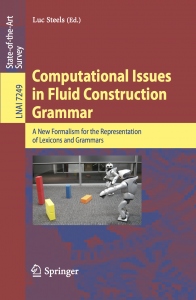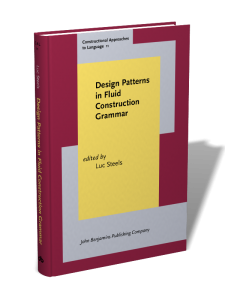The second lecture of the FCG tutorial is now online! The lecture is split in two videos and explains how constructions are operationalized in FCG, how they can be processed, and how complex lexical constructions can be written. You can find the lecture at this page.
News
First lecture online
The first lecture in our new video tutorial series is now officially live. You can check the video and its course materials at this page. The first lecture immediately goes into some technical details about the most basic representation and processing techniques of FCG. The reward awaits in lecture two, where you will learn how these techniques can be used for representing and processing constructions.
Video Tutorial Series
Great news for everyone who is interested in using Fluid Construction Grammar for building NLP applications or conducting computational linguistics research! Starting today, a series of video lectures will be made available on this website that will guide you from the very basics of FCG to full-blown grammar development. Check out the new tutorial webpage for more information.
New FCG release
You can download the latest FCG source code including a new range of construction templates from Babel2 website now. The demos that accompany the 2011 volume on Design Patterns in Fluid Construction Grammar are still included in the release.
Long-Distance Dependencies in FCG
A new paper just got published that explains how long-distance dependencies can be handled in FCG:
van Trijp, Remi (2014). Long-Distance Dependencies without Filler-Gaps: A Cognitive-Functional Approach in Fluid Construction Grammar. Language and Cognition. doi:10.1017/langcog.2014.8
Tutorial on Computational Construction Grammar for Collaborative Open-Source Grammar Development
Remi van Trijp and Katrien Beuls will give a tutorial on computational construction grammar at the LREC 2014 conference on 31 May 2014. The motivation of the tutorial is to create a community of experts that collaborate on open source grammars in different languages. Such an endeavor may have interesting practical purposes — especially in domains that require rich semantics — but is also interesting from a scientific point of view, namely how to operationalize cognitive-functional linguistics.
As follow-up of the tutorial, online training materials and video lectures will be made available. If you are interested in receiving an update on when those lectures are accessible, please mail us at info@fcg-net.org.
Comparing Fluid Construction Grammar to Sign-Based Construction Grammar
A new article just appeared in Constructions and Frames that compares Fluid Construction Grammar to Sign-Based Construction Grammar:
van Trijp, Remi (2013). A Comparison between Fluid Construction Grammar and Sign-Based Construction Grammar. Constructions and Frames 5(1): pp. 88-116. DOI: 10.1075/cf.5.1.04van
Reviews for Design Patterns in Fluid Construction Grammar
The journal Computational Linguistics just accepted a review by Nathan Schneider (Carnegie Mellon University) and Reut Tsarfaty (Uppsala University) of the book “Design Patterns in Fluid Construction Grammar”. You can access the full text here.
Schneider and Tsarfaty write that the book succeeds in “demonstrating the feasibility of implementing the constructional approach in a full-fledged computational framework.” The reviewers also “suggest that the CxG perspective presents a formidable challenge to the CL/NLP community”, and that they “hope this book will be provocative even outside of the grammar engineering community.”
New book release: Computational Issues in FCG
 The new volume on FCG, Computational Issues in Fluid Construction Grammar has been released today at Springer. It targets readers that are interested in the technical underpinnings of the formalism (implementation, formal analysis) and in-depth case studies on challenging topics such as Polish negation, German information structure, Spanish modal scope, etc.
The new volume on FCG, Computational Issues in Fluid Construction Grammar has been released today at Springer. It targets readers that are interested in the technical underpinnings of the formalism (implementation, formal analysis) and in-depth case studies on challenging topics such as Polish negation, German information structure, Spanish modal scope, etc.
You can now download chapters from this website.
- New formalism for the representation of lexicons and grammars
- Investigating language learning and language evolution
- Robust language processing
Keywords » NLP – deep language processing – first order logic – machine translation -morphology
New book on FCG published!
 The book Design Patterns in Fluid Construction Grammar (edited by Luc Steels) is now available at John Benjamins! This book is the first extensive publication on FCG. In addition to general introductions, it gives a number of concrete examples through a series of linguistically challenging case studies, including phrase structure, case grammar, and modality. The book is suited both for linguists who want to know what Fluid Construction Grammar looks like and for computational linguists who may want to use this computational framework for their own experiments or applications.
The book Design Patterns in Fluid Construction Grammar (edited by Luc Steels) is now available at John Benjamins! This book is the first extensive publication on FCG. In addition to general introductions, it gives a number of concrete examples through a series of linguistically challenging case studies, including phrase structure, case grammar, and modality. The book is suited both for linguists who want to know what Fluid Construction Grammar looks like and for computational linguists who may want to use this computational framework for their own experiments or applications.
Together with the book, a new open-source release of Fluid Construction Grammar has been published on this website. This new release contains sample code and demonstrations that illustrate the papers in the book.
Reference
[bibtex key=steels2011design]